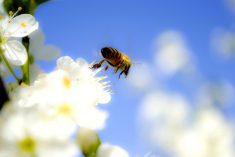Manitoba’s beekeepers will be getting funds to rebuild after suffering devastating winter losses last year.
An industry push for financial aid bore fruit June 20 when the province and federal government announced the Canada-Manitoba Bee Mortality Assistance Program, provided through AgriRecovery.
The program has earmarked up to $7.5 million to ease rebuilding costs, according to a joint provincial-federal news release.
Read Also

What is perfect Christmas weather?
What is ‘perfect’ Christmas weather on the Prairies? Here’s where you should head this holiday, according to historical weather data.
“Beekeepers and healthy bee populations play a vital role in the sustainable production of many high-value agricultural crops,” Canadian Agriculture and Agri-Food Minister Marie-Claude Bibeau said in the same release.
“With support to help overcome this unique sector challenge and recover unexpected colony losses, beekeepers will be better equipped for future growing seasons.”
Why it matters: The honey sector has taken knocks in recent years, ranging from a drought in 2021, heavy losses that winter, a string of storms in the following spring, higher pest pressure and difficulty sourcing replacement stock.
The program announcement was welcome, said Ian Steppler, president of the Manitoba Beekeepers’ Association.
“I’m very excited to be able to get this kind of recognition from the province in regards to the hardship beekeepers have experienced over the last couple of years,” he said. “It’s not just the cash, it’s the recognition of our importance and the place we play within agriculture.”
Last winter was a cruel season for bees across the country, and Manitoba came off worst of all.
Canada-wide, beekeepers reported almost twice the yearly loss seen in the previous 14 years. That’s according to a 2022 report from the Canadian Association of Professional Apiarists. Losses climbed to 45.5 per cent compared to the long-term average of 25.8 per cent.
In Manitoba, beekeepers reported losses of 57.2 per cent, the highest in the nation. The next closest province was Prince Edward Island at 51.9 per cent.
“Producers were subscribing to the safety net programs, but it just wasn’t enough, because so much loss happened all at once and there was no replacement stock to be able to replace these losses. It just caused a whole lot of problems,” Steppler said.
“This program basically just comes in to help relieve some of that financial burden that beekeepers needed to take on.”
He estimated it will take three to four years for Manitoba’s honey sector to fully recover.

The 2021-22 winter was “unprecedented,” noted provincial Agriculture Minister Derek Johnson during the AgriRecovery announcement, adding that the honeybee industry is “a critical component of Manitoba’s economy.”
Honeybees “pollinate many of Manitoba’s key crops, contributing up to $150 million to the province’s agricultural production,” said Johnson.
The province will foot $3 million of the program’s bill. That amount reflects the typical 60-40 cost split between federal and provincial governments under AgriRecovery, which is designed to provide ad hoc emergency aid in the case of agricultural disaster.
Program details
It is important that the program not inadvertently punish producers who take part in risk mitigation programs, Steppler said.
The goal is to focus on exceptional damage caused by exceptional compounding events since the 2021 drought. Those range from spring storms and difficulty controlling pests like varroa mites to supply chain blocks that hindered beekeepers’ ability to import replacement stock.
To qualify for the program, beekeepers must have had at least 50 colonies as of Nov. 1, 2021. A valid beekeeper registration number is another requirement. The beekeeper must have also seen “extraordinary losses” between Nov. 1, 2021, and May 21, 2022.
“Extraordinary loss,” in this case, refers to losses above and beyond the 30 per cent that the province considers normal mortality.
Under the program, producers can get paid for any replacement bees, packaged bees, nucleus colonies or queens purchased to restore their numbers, although only purchases made between the start of 2022 and June 30, 2023 will be eligible.
Repayment rates under the program are set at $210 for colonies, $140 for packages of bees and $35 for each replacement queen.
“Producers must demonstrate they purchased sufficient replacements to cover the normal winter loss for 2021-22. Replacements for normal winter losses, growth or losses over the winter of 2022-23 are not eligible,” the province has said.
Producers who want to apply must email a completed worksheet to [email protected].
The worksheet and full program details can be found at https://www.gov.mb.ca/agriculture/funding/agri-recovery-bee-mortality.html.
Growing pains
While the financial relief is a win in Steppler’s books, he has concerns about the fine print.
To get paid, producers must first be able to buy replacement stock within the eligibility window. Their payments will be based on their receipts.
That is a problem for producers left cash-strapped after difficulties in the last few years.
“There are many beekeepers that, simply put, didn’t have the cash in hand to be able and buy the replacement stock,” he said.
Similarly, producers had little time between the program’s unveiling and the end of the window for eligible purchases. As well, there was little readily available stock for last-minute buying.
Only 10 days separated the program’s launch announcement and the cut off for replacement stock to be bought.
“We were hoping we could have had this announced earlier in May so beekeepers maybe had more of an opportunity to use the program,” said Steppler, but the industry did know the program was coming.
Boxed-bee supply
The sector also wants the Canadian Food Inspection Agency to take another look at rules banning U.S. boxed-bee trade into Canada. Although American queens can be traded into Canada, bulk shipments have been restricted since the 1980s due to biosecurity concerns.
The last risk assessment is a decade old and the honey sector argues that new knowledge may address many of the original concerns.
Approved boxed-bee sources, like Australia or New Zealand, require shipping bees by air.
There were more imported bees available this year compared to the frustrations of spring 2022, Steppler said, but accessing them is expensive and awkward.
“Producers take on a lot of risk bringing this honeybee stock over alive and in good condition,” he said.
In an interview with the Co-operator earlier this year, Steppler noted Canadian beekeepers already get queens from northern California. That shows protocols for trade are already in place in that region, and suppliers are already accustomed to selling to Canada, he said.




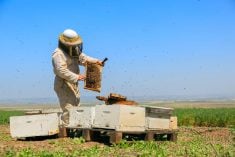
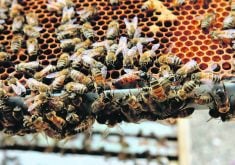
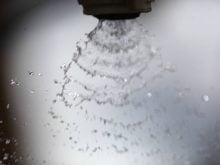
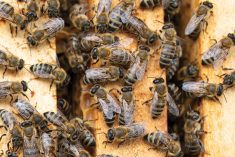
![“It can sit dormant [on] equipment for years and years until hive stressors and hive conditions are right for it to infect the colony.” – Osee Podolsky, Canadian Honey Council.](https://static.manitobacooperator.ca/wp-content/uploads/2023/10/26104651/grafvision_GettyImages-178850019_cmyk-235x157.jpg)
